“After lunch, we’ll drive to Suzdal and meet a local guide at the Museum of Wooden Architecture,” Daria was explaining as our mini-bus bounced over the pot-hole filled roads. I groaned and looked at Tim. We are NOT museum people. We’d much rather learn about the culture, and in this case architecture, by being out and about in the country. As we arrived to the museum though, we were pleasantly surprised. The Suzdal Museum of Wooden Architecture and Peasant Life, as it is officially called, is a living museum with about 20 preserved buildings all taken from the local area.
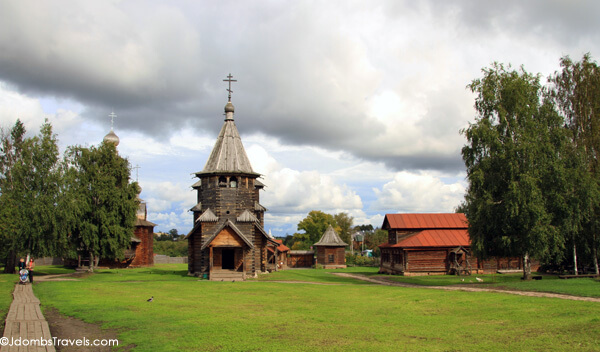
Before we entered, Kate told us of the Russian superstitions around building a house. Russians believed that the first being to enter the house would suffer an untimely death, so they’d send a cat in first. They have nine lives, after all! If the cat willingly went inside, it was a sign that it was a good location for the house. If the cat jumped on the hearth, then the family would be well fed. If the cat curled up in a corner, this was to be the “Red Corner” (red meaning beautiful in Russian), and it served as the place for religious icons in the house. But if the cat refused to enter, then the house would be torn down and the materials were reused to build the house somewhere else.
Related: The Many Superstitions of Russia
Inside, the ground floor served as a type of basement. The chickens and maybe even sheep or goats would live here in the winter. Upstairs, there were just three rooms: a heated room, a mud room, and an unheated room. A Russian oven is the center of the heated room and served the purpose of not only heating the room, but cooking, sleeping on, and even bathing. Lavki (benches) stretching along the walls are the main furniture and during the day, this is where everyone sat. But at night, the benches became places for all of the children to sleep. The mother and father of the house would sleep on a type of mattress above the stove.
The mudroom connected the heated room and the unheated room. The unheated room was used more in summer and in winter was often just used as storage. While the eldest and newly married son built his own home, he and his new bride would live in the unheated room for the first few months of their marriage.
It was common in Russia to pair two churches, called a summer and winter church, so naturally the Suzdal Museum of Wooden Architecture has both. The winter church, Church of the Transfiguration, dating from 1756 was constructed from pine and by using nothing but an axe. It’s domes were covered with silvery aspen shakes (lemech). Unfortunately, the winter church wasn’t open for us to be able to go inside.
The summer church, the smaller Church of the Resurrection, built in 1776 is open for visitors though. What makes it a “summer” church is that it is not heated and so doesn’t hold winter services. Like all Russian Orthodox churches, it features the iconostasis with three levels.
Some other structures in the open-air museum are the windmills, one of which the interior has been restored and is open to visitors, a barn for drying hay, and a 19th-century water well that is operated by a huge wheel. The wheel was turned by men running inside of it almost like hamsters running in a wheel. Only the strongest men of the village could work this job and many women would come to watch and select a husband.
It was really interesting to see and learn about this part of Russian culture. Though visiting museums isn’t our first choice of activities, we’d definitely recommend a visit to the Suzdal Museum of Wooden Architecture. If you go in summer, you might even get to attend some of the popular festivals like the Celebration of the Trinity or the Cucumber Celebration.
Know Before You Go
- The Suzdal Museum of Wooden Architecture is open daily from 9am – 7pm (only until 4pm in winter).
- Entry is 200 rubles per person (about $6 US).
Our trip to Russia was sponsored in part by G Adventures. As always, all opinions are entirely our own.
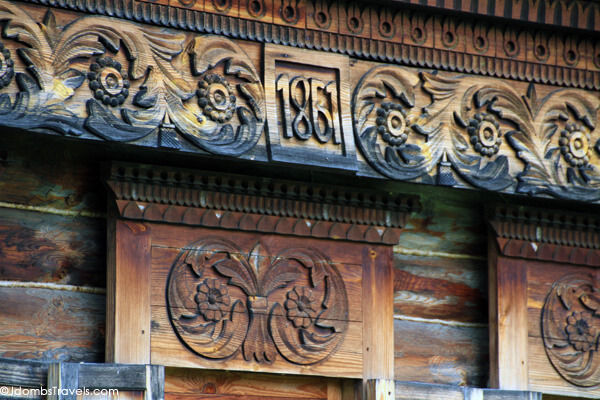
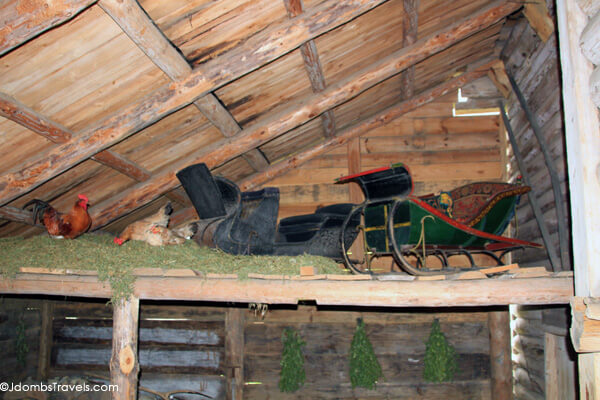
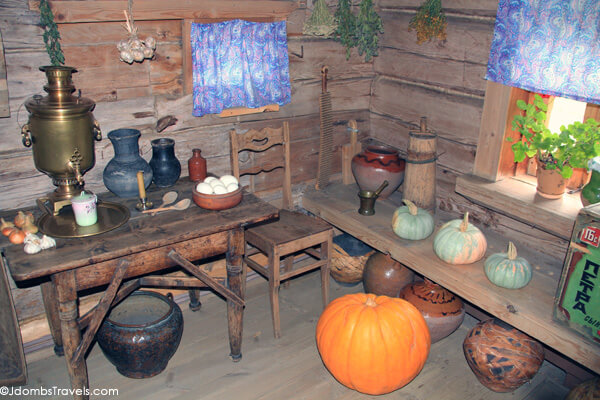

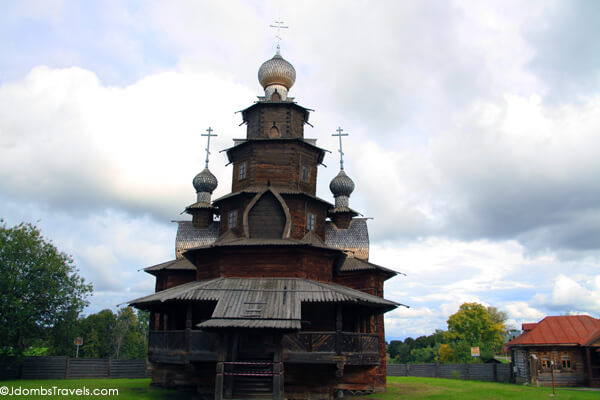
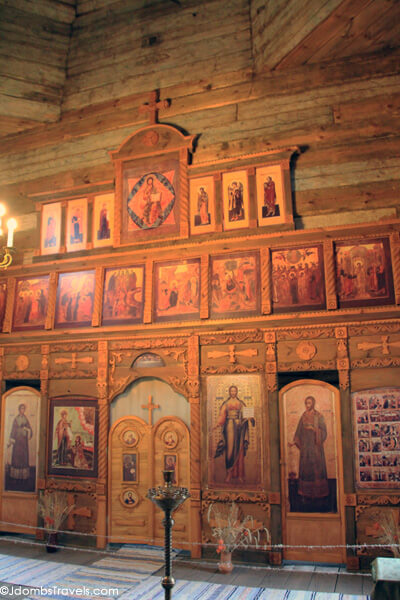

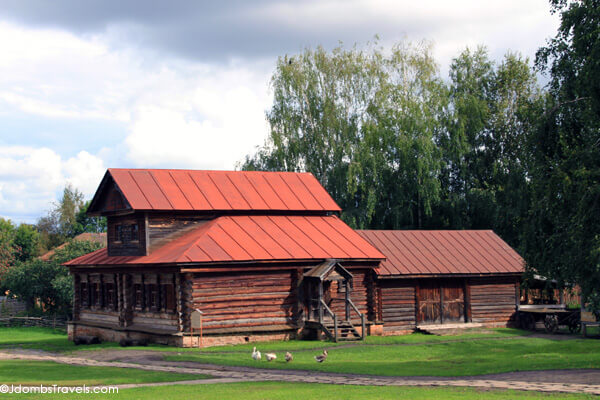
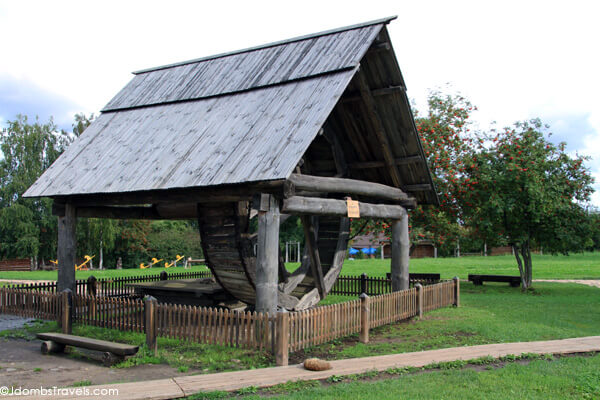
Valen says
Those carvings are done with an axe? That's amazing!!
C.M says
I wonder if something is ”lost in translation”…my son is a Green oak timber framer, and axes are used, but it would be impossible to carve intricate shapes with an axe.
Chisels are what would have done that carving.. 🙂
Larry says
This is fascinating! It’s hard to imagine living a “normal” life under such conditions. Very nice photos.
Jennifer Dombrowski says
It makes you realize that “normal” is just relative really. Even the modern Russian homes we saw in these villages were quite small. They live in only a couple of rooms.
Lori says
So simple and rustic. Going back to nature and roots.
Jennifer Dombrowski says
Yes, very simplistic. No tv or modern conveniences here. Just the pleasure of the company of friends and family.
Bram says
This is a very interesting post, Jennifer. I especially love the photos! 🙂
Jennifer Dombrowski says
Thanks, Bram! The museum was a pleasant surprise and very interesting.
Beth says
That would be really fun to visit a village like this, although difficult to live in!
I had no idea about the cat superstition. Maybe when I start looking for a place to settle down in I’ll have to give it the kitty test!
Jennifer Dombrowski says
The cat superstition still amazes me. I guess my kitty not wanting to leave our house is a good sign then!
Jennifer says
Isn't it?! And the churches are 100% made of wood. Even the "nails" are wood. All built with just an axe. They were quite clever builders.
AngloItalian, Follow Us says
I didn't realize you can do carvings by using an axe, that is an impressive technique!
Franca Calabretta says
I didn't realize you can do carvings by using an axe, that is an impressive technique!
Dusty says
A very interesting article thanks. Loved the story style.
Iain Mallory says
That sounds like an amazing experience. Making wooden carvings from an axe though, even more impressive.
Heather says
I was expecting to see a Potemkin village, but this looks really fascinating! I love museums like this!
Jennifer Dombrowski says
The buildings were brought from around Suzdal to make the village for this museum, but they are all actual buildings that people lived and worked in. It was really interesting!